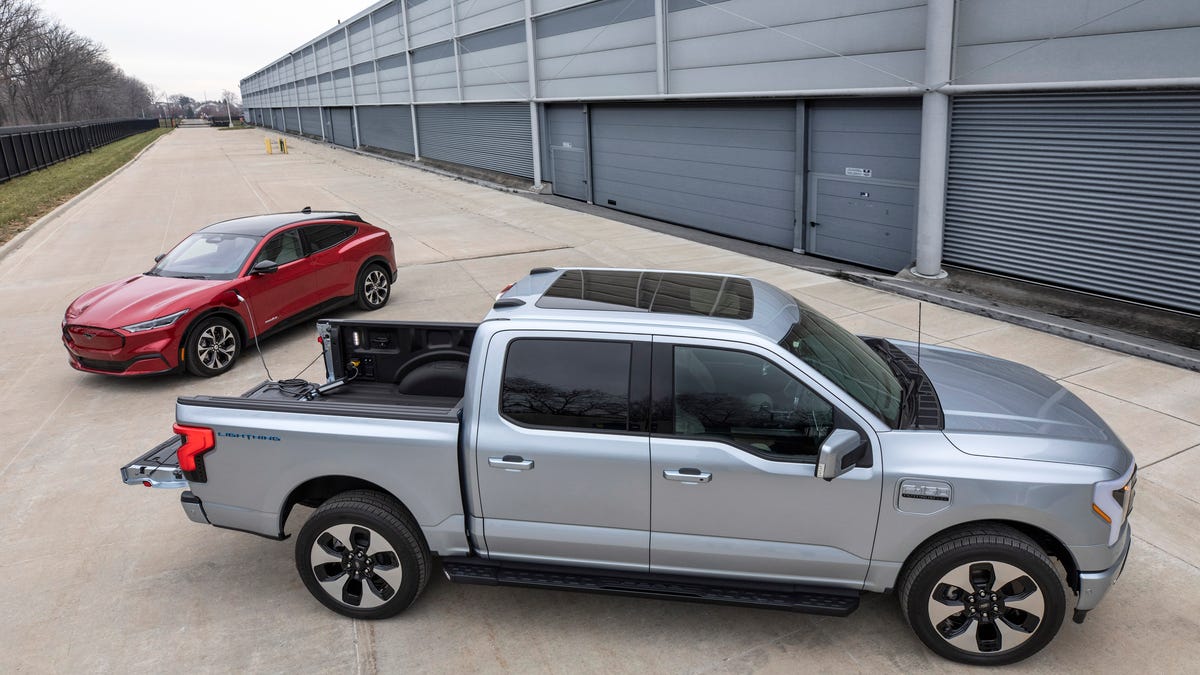
Posted on 07/28/2022 10:55:54 AM PDT by Red Badger

F 150 Lightning charging a Mustang Mach E
Ford expects demand for its F-150 Lightning, Mach-E and the rest of its EV portfolio to grow significantly over the next few year. Ford
What's happening
Ford announced its plans to ramp global electric truck, van and SUV production up to 600,000 units annually by 2023.
Why it matters
Demand for EVs (and the batteries that power them) is expected to accelerate dramatically over the next few years.
What's next
Ford will begin using new, less expensive batteries in the Mustang Mach-E next year and in the F-150 Lightning by 2024.
A question often raised by electric vehicle naysayers, believers and manufacturers alike is, where are we going to get the materials and batteries to power all of these EVs? Ford is confident that it has the answer, announcing Thursday that it has secured materials contracts that will enable a global production capacity of around 600,000 EVs annually by late 2023 and scale to an annual output of over 2 million vehicles by 2026.
Ford cites an EY study saying more than half (52%) of global consumers intending to buy a car in the next two years intend to choose an EV or hybrid electric vehicle. Here in the US, that number drops to 29% of surveyed shoppers, but that's still a lot of demand for electric cars and the batteries to run them. Ford's supply chain solution is twofold: It's diversifying its battery chemistries and partnering with multiple battery and materials suppliers around the world to build the 60 gigawatt hours' worth of battery capacity it'll need each year to meet demand.
The automaker says that it will begin adding lithium iron phosphate (LFP) cell chemistry into its product portfolio alongside the current nickel cobalt manganese (NCM) packs beginning with the Mustang Mach-E next year and the F-150 Lightning electric pickup in 2024. LFP has the advantage of using less rare materials in its chemistry, making it easier to source and less expensive per kilowatt-hour, about 10% to 15% less expensive according to Ford's estimates.
Ford's announced partnerships with Contemporary Amperex Technology, LG Energy Solutions and SK On will support the full goal of 600,000 global EVs annually. Ford said it expects it'll be building 270,000 Mustang Mach-Es for North America, Europe and China, 150,000 North American F-150 Lightnings and 150,000 Transit EVs for North America and Europe each year by the end of 2023. The automaker also has plans to introduce an annual run of 30,000 examples of an all-new European SUV within the same time frame.
Looking further down the line, Ford expects EV adoption rates to continue to accelerate over the next decade. To keep up with the growth, it's also announced a goal of an annual run of 2 million EVs globally by 2026 and that it has sourced about 70% of the future materials capacity needed (about 1.4 million cars' worth) toward hitting this mark. The plan includes around 40 GWh per year of LFP production capacity and utilization in North America by 2026 along with continued cooperation with CATL for global battery supply. Other direct partnerships with mining companies will provide Ford with sourcing of battery raw materials in North America, Australia, Indonesia and other global sources.
Good post—I was wondering about the electrical infrastructure.
It was built for a different time.
The excrement is gonna hit the rotating blades big time if this EV push continues for any period of time.
You will own nothing and be happy...... Klaus Schwab.........
No they won’t. They’ll need a solar array bigger than anyone has installed right now to adequately charge an EV; and that will be far down the list after keeping the lights on in the house and the building heated adequately.
If the EV owner is the only one moving; they’re not going to get very far anyway. Besides getting hijacked, if they manage to avoid ambush, they won’t be able to venture far from the vast solar array; and there won’t be anywhere to go besides with everything closed.
Today’s headlines illustrate the problem: $7,500 tax breaks for EVs. Why in the HELL should I make it easier for someone else to buy an EV?
Electric bus just caught fire in connecticut.
So they shut down the entire electric fleet!!!
600,000 x $7,500 welfare= a nice profit.
I think that’s a significant reason school bus fleets aren’t jumping into electric. From a duty cycle point of view, they would be perfect.
The “experts” said that only one in thirty thousand electric buses would catch fire.
New Haven CT had five buses.
One caught fire.
Oops.
This “electric vehicle” stuff is gonna be fun to watch at scale.
The lawsuits may be epic.
We have electric articulated buses from BYD (Chinese OEM, US manufacture in Calif) here in Indianapolis. I think the biggest problem is short range in cold weather.
What are they going to do with them all.
By the way, multiply that by $7,500 and imagine what your future taxes will be to pay for all the people buying electric cars.
Where are they going to find enough lithium for this?
AFGHANISTAN......................
The fun will start at large scale.
There are always “unusual” problems that don’t show up in early tests.
In addition not all localities will do proper maintenance—so it will be interesting to see how they operate under sub-optimal conditions.
Imagine what your future ELECTRIC BILL will be to pay for all the people CHARGING THEIR electric cars....................................



If I was running a fleet of school buses, I would definitely be reluctant to jump in, despite likely federal gravy facilitating it.
OMG! Excellent point! We need to get active and make sure the utility boards in each state figures out a way to keep that separate from household utilities.
Actually people with electric cars should be required to have solar panels on their charges so they don’t tap into the grid.
Didn’t Ford not get a bailout?
It would be ironically sweet if a state made a law that required EV owners to buy a NG powered GENERAC to charge their EVs!.......................
“No they won’t. They’ll need a solar array bigger than anyone has installed right now to adequately charge an EV;”
What is the output of a solar system and what is the input required to charge an EV?
Answer those questions and you’ll find you made an ignorant post.
Disclaimer: Opinions posted on Free Republic are those of the individual posters and do not necessarily represent the opinion of Free Republic or its management. All materials posted herein are protected by copyright law and the exemption for fair use of copyrighted works.